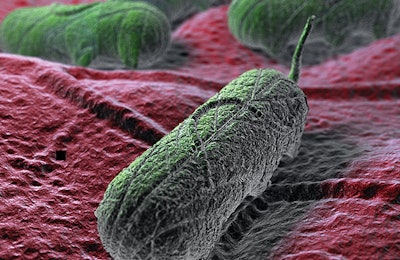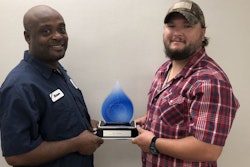
Multiple factors can influence both Salmonella prevalence and diversity of serogroups detected from both pre- and post-harvest samples.
Sampling methodologies vary widely when sampling the environment, individual live birds, carcasses and parts. Furthermore, protocols for analyzing the samples following collection can also impact both prevalence and serogroup diversity.
With more than 2,400 serotypes, it is reasonable to expect that different Salmonella serotypes will have differing abilities to grow and compete in environments such as dust, litter or the ceca. Even different isolates of the same serotype can have a greater or lesser ability to colonize birds.

An example of a hand-grab of litter including feces. | Courtesy Dianna Bourassa
Salmonella prevalence is impacted by sampling method
Environmental sampling
Many different production house environmental sampling methods for the recovery of Salmonella on the farm have been studied. Environmental sampling methods can be divided into two categories.
Direct methods incorporate removal and analysis of samples such as feces, litter or dust. Surface sampling methods rely on contact between the environment and the moistened sampling media such as: conventional drag swabs; socks, or moistened absorbent fabric placed on a shoe; shoe covers and intermittently stepped on drag swabs (ISODs).
When direct sampling methods (feces and litter) and surface sampling methods (drag swabs and socks) were compared, sampling with socks had the highest percentage of samples positive for Salmonella. When several surface sampling methods (drag swabs, ISODs, and socks) were further compared, ISODs and sock methods that incorporated a greater contact pressure with the litter surface from using a foot to step on the sampling material were more sensitive for low levels of Salmonella compared to conventional drag swabs, which are simply dragged across the litter surface.
Overall, when collecting house environmental samples for the detection of Salmonella, sampling methods that include stepping on the moist sampling material while in contact with the litter are more sensitive than conventional drag swab sampling of the litter surface.

An example of a pre-moistened sock used for litter sampling. | Courtesy Dianna Bourassa
Individual bird sampling
In addition to environmental samples, flock status can also be determined thorough individual bird sampling. These types of samples can either be non-destructive or destructive, and include cloacal swabs, individual bird feces and intestinal ceca. For non-destructive methods, cloacal swabs and fecal samples, fecal samples are more sensitive for Salmonella detection than cloacal swabs. When using a destructive sampling approach, sampling ceca resulted in the most positive samples.
When sampling in a turkey production facility comparing ceca (destructive method) and environmental swab samples (non-destructive), sampling ceca was three times more sensitive than environmental swabs. For individual bird testing, ceca or fecal samples are the most sensitive for detection of Salmonella due to the higher resident levels of Salmonella compared to swabbing the cloaca epithelial surface.
Sampling time
In addition to what samples are taken, when the samples are taken can also influence the ability to detect Salmonella. During broiler growout for both ISODs and ceca sampling methods, Salmonella can be detected at the highest frequency at about three weeks of age, after which detection steadily declines from three to six weeks of age. A similar trend is seen in turkeys where the greatest number of samples are positive for Salmonella during rearing at 14 days of age. The frequency of positive samples decreased after 14 days through 20 weeks.
Feed withdrawal can also influence the ability to detect Salmonella. When broilers are subjected to feed withdrawal, the crop empties within six hours and the pH within the crop increases to near neutral leading to the growth of enteropathogens such as Salmonella when present. In a study where Salmonella negative broilers were placed on Salmonella positive litter during feed withdrawal, Salmonella was frequently detected (48%) from crops and occasionally (5%) in the ceca after 12 hours.
In addition to feed withdrawal prior to processing, restriction feeding of breeders may also impact Salmonella proliferation and persistence. When every-day and skip-a-day feeding programs with broiler breeder pullets were compared, pullets that were fed every day had a lower prevalence and shorter persistence of Salmonella than pullets that were fed with a skip-a-day program. Emptying of the crop every other day, allowing for an increase in crop pH and litter picking may contribute to a higher prevalence and persistence of Salmonella positive ceca.
Salmonella sampling in slaughter plants
During turkey and broiler processing, multiple sampling methods including whole carcass rinse, excision (skin or muscle), swab, neck skin and whole carcass enrichment have been evaluated for the detection of Salmonella.
For turkey carcasses, methods that require sampling of a larger surface area of the carcass (whole carcass swabbing and whole carcass rinse) are more sensitive than one or two site swab sampling. Following immersion chilling, whole carcass enrichment was the most sensitive method; neck skin less sensitive; and whole carcass rinse the least sensitive.
Although sampling methods vary in sensitivity, each method has a minimal level of detection. The most sensitive method (whole carcass enrichment) requires approximately eight to 10 cells present on the carcass for a positive result following 24 hours of enrichment incubation.
Therefore, any product sampled can never really be declared Salmonella-free. The absence of a positive result from a carcass or 325 grams of comminuted product does not indicate that there is no Salmonella present. Use of the phrase zero tolerance may lead consumers to believe that there is no Salmonella on raw product and may give a false sense of security.
Serogroup diversity is impacted by sampling and analysis methods
When the detection of Salmonella serogroups was analyzed following three different carcass sampling methods – neck skin, whole carcass rinse, and whole carcass enrichment – the greatest number of serogroups was found with whole carcass enrichment (five serogroups) followed by neck skins (two serogroups), followed by whole carcass rinse (one serogroup). The greater serogroup detection may be due to incubation of the carcass or skin within the rinse media.
Incubation in the media would have allowed for Salmonella that was tightly attached to the carcass to be detected while the whole carcass rinse sample would only contain those Salmonella that were more easily rinsed off during sampling.
Sample enrichment and the use of selective media are commonly used when culturing for Salmonella. If multiple serotypes are present, the serotypes will grow at different rates impacting the likelihood of detecting one serotype over another.
When Salmonella Newport, Enteritidis and two Typhimurium strains were compared, the probability of detecting one serotype was not directly related to the initial number of cells in the selective media. In addition to serotype competition and variable growth rates, the number of colonies selected per plate for analysis can also impact the serotype results.
For example, if a serotype 1 and a serotype 2 in a mixed culture grew so 90% of the Salmonella present after incubation were serotype 1 and only 10% of the Salmonella present were serotype 2, there would be a 90% chance that only serotype 1 would be detected if only one colony was picked for identification. If three colonies were picked, there is a 73% chance of selecting only serotype 1, an 8% chance of selecting both, and a 0.1% chance of selecting only serotype 2.
Differing abilities of certain serogroups to grow during cultivation may impact which serogroups are recovered. However, those serogroups recovered may not be representative of the serogroups present in the original sample.
References available upon request.

















